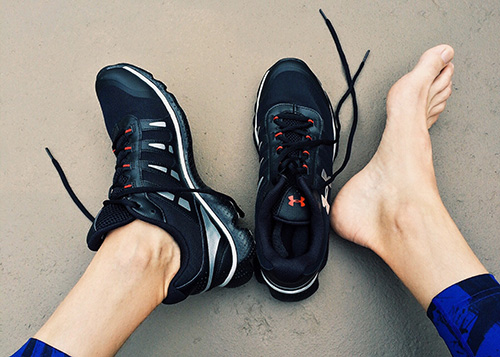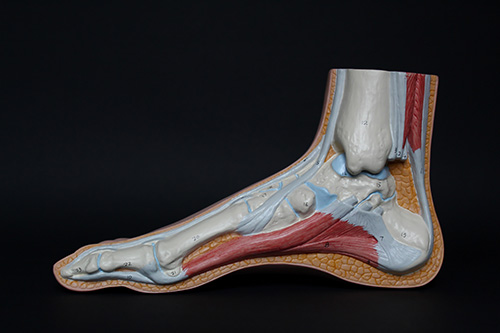Achilles Tendinopathy
AKA: TENDONITIS/TENDINOSIS
 WHAT IS IT?
WHAT IS IT?
A tendinopathy is the acute or early stages is basically tendon overload, where the tendon has been stressed and strained beyond its current capacity. At this point in time there is no actual damage to the tendon but it is not coping well and will continue to struggle without appropriate treatment. In the later more chronic stages the tendon starts become damaged and its much weaker than a normal healthy tendon would be.
WHAT CAUSES IT?
Achilles tendinopathy develops due to a variety of factors. This is an extensive list of possible factors that may be contributing to your tendinopathy. Some of these factors may not or not be relevant to you. Your physiotherapist will notify you of which ones you will be focusing on as part of your rehabilitation. Without addressing all of the factors that are negatively affecting you individually you may find that your issue comes and goes – it appears to get better but returns after a period of time. This means that certain contributing factors still remain or your rehabilitation was not complete.

CONTRIBUTING FACTORS – BEETROOT
B – BIOMECHANICS
This relates to different aspects of the body and composition that may predispose someone to
overuse injuries over time. This can be movement dysfunctions, structural or anatomical faults or muscle imbalances. For example:
1. Muscle strength and power
2. Reduced ankle movement
3. Foot posture.
4. Foot alignment
E – ENVIRONMENT
Relates to a change in different factors outside of yourself rather than in your body. A change in an environmental factor may create overload onto tissues. For example:
1. Sudden changes in surfaces.
2. Softer surfaces are more prone to achilles tendinopathy.
3. Excessive hill/stairs/walking/running.
E – EQUIPMENT
These factors relate to sudden changes in equipment that you may use for either various activities such as exercise but also everyday types of equipment such as work
shoes etc. Examples are:
1. Worn out shoes
2. Heels counter that is too high
3. Change in shoes
T – TRAINING / ACTIVITY
This relates to sudden changes in volume or intensity of exercise or movements. This can be as simple as you had to do more walking at work this week or decided to start
running recently. A few examples are as follows:
1. Sudden changes in loading (e.g. return from an off-season).
2. Sudden increases in training or activity.
3. Increases in intensity.
R – RECOVERY
Poor recovery practices may lead to the muscles and tendon fatigue. All tissues (articular cartilage, tendons, muscles, bones) have the ability to adapt when worked in the right amount at the right time. It is well known and accepted that repeat episodes of tendon loading can be beneficial to developing strength in the tendon. However, if the loading cycles are too great and too close together, then overuse tendinopathy may develop as a result. For example:
1. Insufficient recovery between loading days
2. Lack of appropriate rehabilitation to recover tendon health
O – OLDER
It is accepted that due to the natural ageing process, DNA markers and hormonal changes, that the white tissues do not recovery as quickly after the age of 30. These tissues include articular cartilage, meniscus, labral tissues, tendons, fascia and intervertebral discs. Older athletes do not recover as fast as younger athletes due to dropping hormone levels after the age of 30. Therefore, older persons, especially in relation to sports, may be more prone to achilles injury compared with younger persons if subjected to the same stress or training. Often older persons need more recovery time between sessions or bouts of activity.
O – OVER-REACHING
This relates to all the factors in a persons life that may impact on their wellbeing such as work stress, home stress, relationships, sudden changes in circumstances, death of a family member can all provide extra emotional, social and psychological stress that all may influence the crucial balance in your bodies systems that may leave you at increased risk of fatigue and therefore more vulnerable to reaching that overloaded state.
T – THREATS
Known risk factors for achilles tendinopathy include:
1. Previous tendinopathy (poorly rehabilitated).
2. Steroid exposure.
3. Obesity, diabetes mellitus – (reduces ability of tendon to strengthen after load), hypertension.
4. Certain gene types
5. Contraceptive pill.
TREATMENT
In order to successfully treat achilles tendinopathy, it’s vital that all the factors that are contributing to your issue are addressed properly. Otherwise it is likely that your issue will feel better but be prone to flare ups and you will be caught in a cycle without resolution. It’s quite difficult to know when the tendinopathy is actually treated or if it’s still present if you don’t have significant knowledge and experience in this area. Your physiotherapist will know exactly how to test and evaluate where your tendinopathy is up to at any stage and what treatment and exercise is best at the right time. It is crucial that the right treatment is administered at exactly the right time in exactly the right amount, like a dosage of medication. Your physiotherapist will be your guide and coach you along the right path for you at each stage of your rehabilitation.
